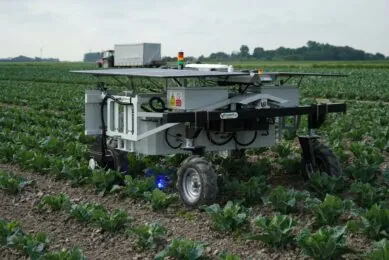4 more ag robots that debuted at World FIRA 2023

During World FIRA from 7 to 9 February this year, some 10 field robots were shown for the first time to an international audience. Most of these took part in the robot demos to show the fruits of their developments.
The details about the new Traxx Concept H2, E-Terry and SoftiRover e-K18 can be found here while Teyme demonstrated its Weta autonomous sprayer robot in Toulouse/Auzeville-Tolosane as well. Right below, we go into more details about the news from Ant Robotics, Digital Workbench, HariTech and Léger.
Ant Robotics Valera cobot prototype
Ant Robotics from Germany showed their first prototype of their Valera cobot for transporting manually harvested fruits and vegetables. According to the startup founded in 2021, pickers spend up to 25 percent of their time carrying crates with harvested fruits across the field. The Valera cobot is designed to take over this transport work by following the pickers automatically by means of patented software technology.

The vehicle can carry 450 kilograms of harvested delicate fruits and vegetables like strawberries and asparagus. By taking over the transport of crates or bins with harvested products from 8 pickers, Ant Robotics believes a 30 percent increase of productivity is possible resulting in savings of € 250 per day.
It initially has been developed for the yield quantities of 180 m long strawberry fields. The design can be adapted to other row/bed/plant distances and various field sizes. The company name is by the way derived from the collaborative way of working of ants.
The 200 kg lightweight vehicle is propelled by the energy generated from its rooftop solar panels. The power of the electric driveline amounts to 1 kW (1.6 hp). Its operating speed varies between 0 and 3 km/h. Price indication: € 24,000 to € 26,000.
Digital Workbench Tipard 350 carrier prototype
Also from Germany is the Digital Workbench Tipard 350 carrier prototype. The company and its people have a background in the automotive sector. They now want to leverage the gained expertise to develop robotic solutions such as their Tipard 350 carrier platform.

Although the presented vehicle still is a prototype, it showcases the self-levelling hydraulic chassis the company has developed. This enables the 350 kg vehicle to automatically adapt the orientation of the platform depending on the situation in the field.
Digital Workbench not only paid attention to details like the self-levelling chassis, it also developed a special so-called LoCAT RTK-GNSS receiver that offers a 1 cm accuracy for mapping the position of seeds. For navigation, it relies on cameras for (multiple) row and curve detection. Tests are being done with radar and ultrasonic sensors as well.
With the concept, or rather the technology stack, the company is especially targeting organic farmers, row crop farmers, vegetable growers, tree nurseries and plant breeding companies.
HariTech Haribot
While practically all field robots and vehicles demonstrating on the grounds of the Agrobiopole were powered by solar panels and/or batteries, Hungarian company HariTech was the exception. It showed two 25 hp diesel engine powered robotic carrier vehicles called Haribot designed for tree nurseries and plantations.

The company who runs its own tree nurseries as well, says Hungarian growers seek proven, reliable and easy to repair technology and therefor favour combustion engines. Due to the lack of (skilled) drivers and operators, they are however interested in autonomous solutions.
Such as the Haribot field robot equipped with three drills/augers to drill holes for planting trees that was developed because HariTech couldn’t find a vehicle to their liking on the market. Today, most Hungarian farmers still make these holes by hand says the company.
Drilling holes however is just one of the applications of the robot. The high clearance (up to 1.0 m) machine is used in tree nurseries with (very) small row distances such as 70 cm. Cameras that provide remote monitoring of the work being done are currently in development.
Both robots are for sale for € 75,000. So far, 11 machines are operational. Three have been sold and eight are rented to farmers.
Léger RoboCut 360
Léger, a French company specialised in machinery for plum and hazel orchards and vineyards showed their RoboCut 360 field robot prototype equipped with the existing EcoCut 360 pruner head.

The combination is designed to prune suckers/spurs at the bottom of hazelnut trees and to trim weeds between the trees. Common practice is to use the pruner attached to a tractor driving slowly at about 1.5 km/h.
Léger say they created their own autonomous platform to prevent being depended on suppliers. Other machines can also be attached to the robotic vehicle. The prototype is fitted with a 20 hp diesel engine working as a generator for the onboard batteries.
The typical working speed while pruning is 2 km/h. A price for the RoboCut isn’t available yet, the EcoCut 360 costs around € 15,000. Léger aims to sell a few RoboCut field robot per year after the commercial introduction in 2024.
Join 17,000+ subscribers
Subscribe to our newsletter to stay updated about all the need-to-know content in the agricultural sector, two times a week.



